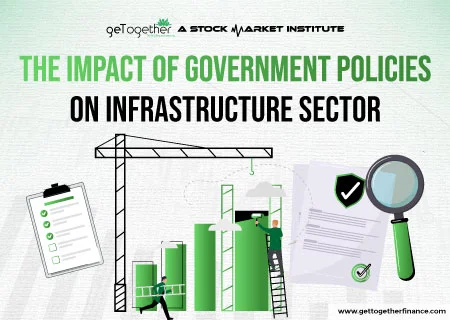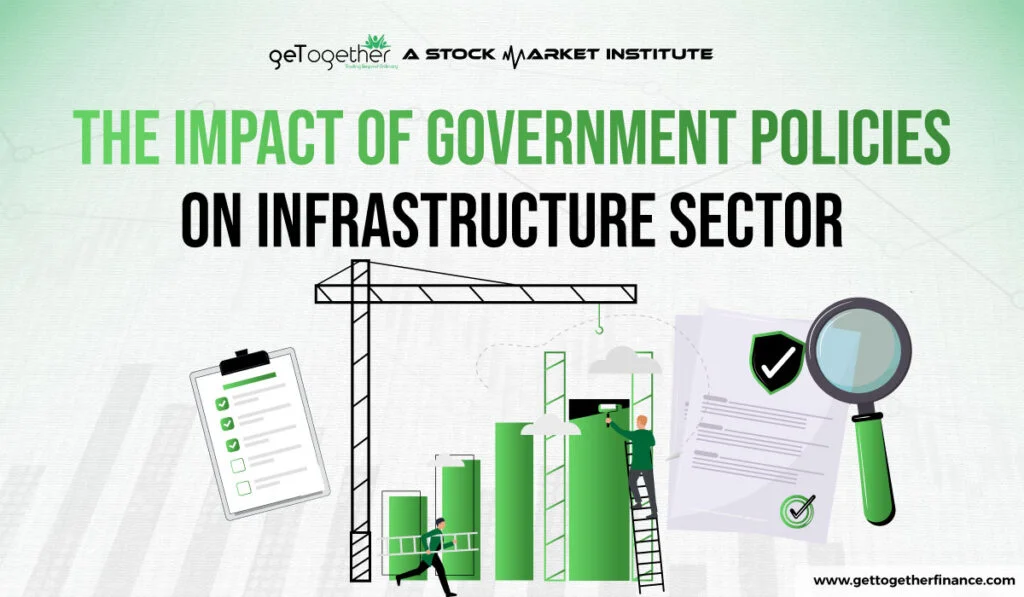The Impact of Government Policies on Infrastructure Sector


Table of Contents
ToggleOverview
The Indian government has been striving to make India one of the fastest-growing economies. This has given push to every sector. Especially the infrastructure sector of India. The infrastructure sector has seen propelling growth in India for the past 10 years. The exorbitant government funds are getting allotted to the sector for development. This is leading to the stage formation of all future possibilities of India.
The vision of India of making India a $47 trillion economy is going to be fueled a lot by the infra development. The government is not only focusing on physical infrastructure but also on digital infrastructure to make a global impact.
The ambitious infra projects lead us towards a prosperous future and developed nation for our future selves and generations. Let’s study how and what government policies are creating impact on the sector
Government Policies for the Infrastructure Sector

India is heading towards one of the best phases seeing the growth pace of the economy. The central focus in this growth journey is the infrastructure sector which is impacting the lives of every generation in some or the other way. The sector in India comprises rail, aviation and road networks, sustainable cities, water, energy, telecommunications, health, and education among others. As you can see, in some or the other way, it is connected to every one of us.
National Infrastructure Pipeline
The government of India introduced the National Infrastructure Pipeline, where they made a public announcement for a group of social and economic infrastructure projects in the period of coming five years. The initial sanctioned amount for the scheme was ₹102 lakh crores, which made it clear to the people of India that the infra sector is going to get a good boom. Further, this pipeline was first made public by the PMO of India, Shri Narendra Modi during his 2019 Independence Day speech.
PM Gati Shakti
Another great initiative by the government to give a boom to the infrastructure sector is PM Gati Shakti. This project aims to incorporate infra schemes with different ministries and state governments like Bharatmala, Sagar mala, inland waterways, dry/land ports, UDAN, etc. it aims to fund infra projects for textile clusters, pharmaceutical developments, construct deference corridors, electronic parks, agri zones, etc. All these will be covered under the scheme for enhanced connectivity among the sectors and to make Indian businesses more competitive on domestic as well as global grounds. One of the best things about this scheme is that it will leverage technology including spatial planning tools with the help of ISRO (Indian Space Research Organisation)
Smart Cities Mission
The objective of smart cities’ mission is to promote cities that provide core infrastructure and give a decent quality of life to their citizens. It aims to promote a clean and sustainable environment with the help of “Smart” solutions. The focus of the government in sustainable development is to look at compact areas and create a replicable model that will act as an inspiration or lighthouse to other aspiring cities. The smart cities mission of the government is a blog and new initiative to exploit the infrastructure sector opportunities. It is meant to set examples that can be utilized and replicated both outside and inside the smart cities.
Budget Allocation to the Infrastructure Sector

According to the interim budget 2023-24, the surge in the infrastructure sector is a long-term part of India’s economic growth. In the interim budget of 2023-24, Nirmala Sitharaman allocated ₹1.3lakh crores as a 50-year interest-free loan to state governments for infrastructure development.
For FY 2025, the allocation for the infrastructure sector has increased to 11.11 lakh crores, which will account for almost 3.4% of India’s GDP.
The finance minister also conveyed that economic corridor programs for energy, mineral, and port connectivity will be constructed by the railway of India.
Impact of Government Policies on the Infrastructure Sector

India’s infrastructure sector has grown enormously during the last 10 years as a result of government initiatives and large investments from both institutions and retailers. Institutions have funded the project as well as the stock market domain of the infrastructure sector. Whereas, retailers have shown immense interest in the infra sector of the stock market. Further, the Indian government has launched numerous policies and programs to alter the country’s infrastructure and position it for long-term economic prosperity.
The National Infrastructure Pipeline (NIP), which started in 2019, is one of the core drivers of this boom. Over the next five years, the NIP would invest 102 lakh crores in different social and economic development projects. This competitive approach has resulted in the construction of significant transportation, energy, and infrastructure projects, laying a solid foundation for future growth. This collectively promotes the related sectors and investment in them, leading to the fulfilling future of India and the Indian economy.
Prime Minister Gati Shakti’s plan has fueled infrastructure development by combining projects from multiple ministries and state governments. This program intends to promote connectivity with initiatives like Bharatmala (road development), Sagarmala (urban expansion), and UDAN (regional network). Prime Minister Gati Shakti has pledged to, including ISRO’s mapping tools, to improve the efficiency and coordination of important projects while also wooing investors to India. This collectively shows that all infra-related sectors as well IT, and science and technology sectors are going in good flow.
Another key program, the Smart Cities Mission, aims to rejuvenate cities by promoting sustainable and efficient models. This effort focuses on key infrastructure, quality of life, and environmental sustainability while creating replicable models for other towns. This promoted smart urban growth, which has not only raised the city’s standard of living, but it has also encouraged investment in green and sustainable infrastructure. Making India more dependable.
The numerous funding promises from the government of India demonstrated the government’s commitment to infrastructure development. For example, the interim budget for 2023-2024 allotted 1.3 lakh crores for a 50-year interest-free loan to state governments, whereas the budget for FY 2025 allocated 11.11 lakh crores, or 3.4% of India’s GDP.
Overall, these policies have resulted in robust growth in India’s infrastructure sector, drawing new investors and laying the groundwork for a long-term economy. Continuing infrastructure is critical to India’s objective of becoming a $47 trillion economy, providing jobs and improving the quality of life for its people.
Also Read: FMCG Sector
Infra Sector of Stock Market

The Indian stock market has seen exorbitant bull rallies following the pandemic. This is the result of people’s increased interest in stock markets and the government’s unwavering initiatives in uplifting sectoral development with the phenomenon of sector rotation.
The infrastructure sector of the stock market is nowhere behind. With the great development in the field, the market is also reflecting its growth. Retailers are engaging more with infra stocks and investing their money in them. Apart from this, the technical analysis of stocks of NIFTY INFRA is showing good growth over time. This makes it a win-win situation for investors from fundamental as well as technical points of view.
Conclusion
To summarize, the Indian government’s strategic initiatives and huge investments have greatly accelerated the expansion of the infrastructure sector during the last decade. Initiatives such as the National Infrastructure Pipeline, PM Gati Shakti, and the Smart Cities Mission have paved the way for long-term and equitable growth. These efforts have not only improved physical and digital infrastructure, but have also sparked increased investor interest, resulting in economic growth. The increase in budget allocations and emphasis on connection, sustainability, and technological integration demonstrate India’s determination to become a $47 trillion economy. The expanding infrastructure industry, combined with a bullish stock market, promises a prosperous future for India, raising individuals’ living standards and generating numerous chances.
Frequently Asked Questions
What is the National Infrastructure Pipeline (NIP), and how does it affect India’s infrastructure development?
The National Infrastructure Pipeline (NIP) unveiled in 2019 allocates ₹102 lakh crores for social and economic infrastructure projects over five years. It intends to improve India’s transport, energy, and telecommunications infrastructure, creating the groundwork for future growth and attracting large investments.
How does PM Gati Shakti assist the growth of India’s infrastructure sector?
PM Gati Shakti coordinates infrastructure projects across different ministries and state governments, focusing on initiatives such as Bharatmala (road construction), Sagarmala (port development), and UDAN (regional aviation connectivity). It enhances project efficiency and coordination by employing modern technology, such as ISRO spatial planning tools, while also increasing connectivity and competitiveness.
What are the Smart Cities Mission’s objectives in India?
The Smart Cities Mission seeks to modernize metropolitan areas by encouraging environmentally friendly and efficient city concepts. It prioritizes fundamental infrastructure, increasing quality of life, and maintaining environmental sustainability. The objective develops reproducible models to inspire other cities and encourage investment in green and sustainable infrastructure projects.
How has government funding affected the infra sector in recent years?
Significant financial commitments have demonstrated the government’s commitment to infrastructure development. For example, the interim budget for 2023-24 allocated ₹1.3 lakh crores as a 50-year interest-free loan to state governments, while the FY 2025 budget allocated 11.11 lakh crores, accounting for 3.4% of India’s GDP. This financial backing has driven continued expansion.
How has the expansion of the infra sector influenced the Indian stock market?
The robust growth of the infrastructure industry has resulted in increased interest and investment in infrastructure equities. Following the pandemic, the Indian stock market has seen favorable patterns, with retailers increasingly investing in infrastructure stocks. The technical analysis of stocks in the NIFTY INFRA shows favorable growth, making it an appealing sector for investors from both fundamental and technical viewpoints.



 Instagram
Instagram
